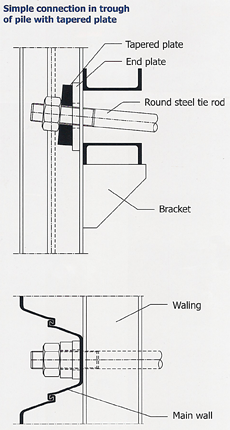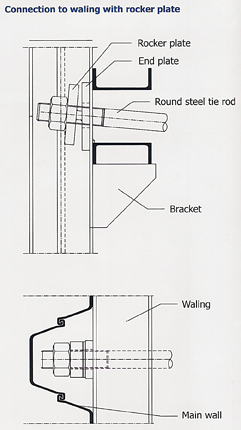Waling joints
The connection between the
anchor and the main wall can be positioned in the trough of the sheet
pile, either at front, on the sheet pile wall itself, or at the rear, on
the waling (tension waling). The spacing of the anchors is then
governed by the system width of the sheet pile wall.
End plates are necessary and we distinguish between front plates on the main wall for U - and Z - sections, and plates for the connection between the waling and the main or anchor wall, with or without additional (threaded) rocker plates.
To improve the load transfer, the front plates at the main wall should generally cover approx. 80% of the width of the trough of the sheet pile. A tapered plate can be used in addition to the end plate to compensate for the angle of a raking anchor.
When settlement is expected, the anchor connection should be hinged and allow movement in the vertical direction in order to avoid any bending stresses at the threaded joints. To allow movement, a rocker plate or threaded rocker plate is normally used.
A rocker plate has a fabricated web that allows the anchor to rotate, and when subjected to moments, stresses close to the yield stress occur, which permit angular rotation without any particular resistance. Rotation with a threaded rocker plate is possible thanks to the half-roller welded to the plate.
If horizontal movements are expected as well, either two opposed hinges can be arranged one behind the other, or a universal rocker plate can be used. A hinge effect can also be achieved by using an anchor with spherical T-head. Where the depth of the wall is limited, a threaded rocker plate can be used to save the depth of the nut.
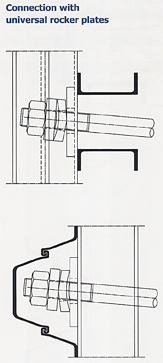
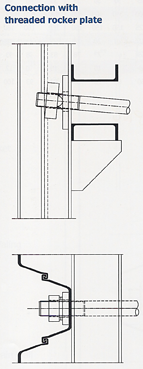
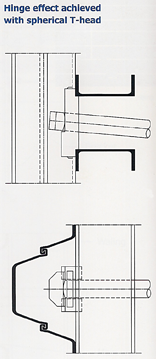
For anchors at steep angles or where excessive settlement or rotational movements are expected, recommendation is to position the anchor connection in the through of the sheet pile wall, but bellow the waling. The latticing of the waling can then be kept small. Where anchors must be installed at a spacing that does not match the sheet piles, anchors can only be connected to the walings. Again, various details are possible here depending on the particular requirements.
The connection to a wall that includes tubular piles is generally achieved via T-connectors that pass through the wall of pile. These are introduced into the tubular pile from above.
At the anchor wall, the anchor is connected via the waling, which is fitted to the outside here (compression waling). A simple connection with the end plate only is normally used.
A hinged connection is necessary, for example, when the anchor is laid in filled ground over its entire length and settlement is likely.
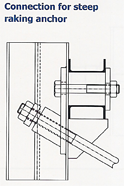
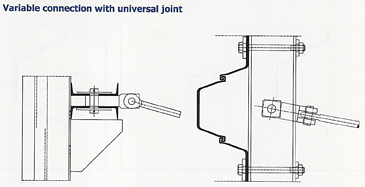
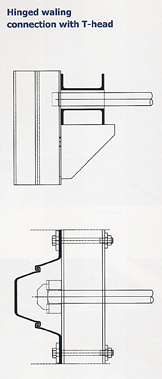
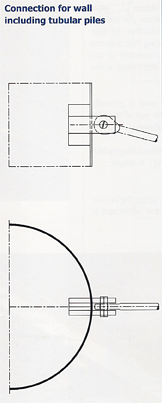
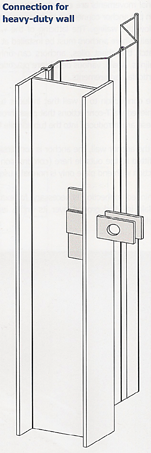
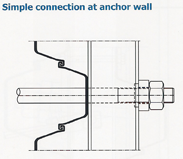
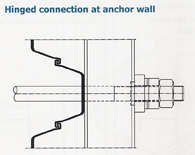
Connection at waling using end plate with spherical recess and spherical collar nut
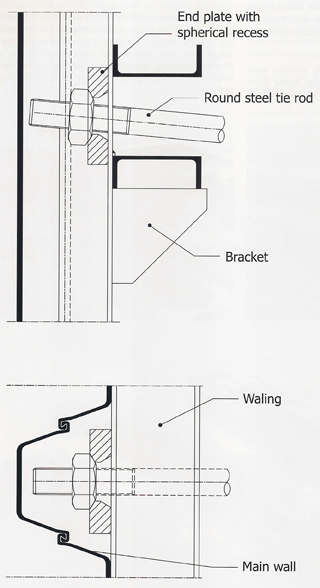
End plates are necessary and we distinguish between front plates on the main wall for U - and Z - sections, and plates for the connection between the waling and the main or anchor wall, with or without additional (threaded) rocker plates.
To improve the load transfer, the front plates at the main wall should generally cover approx. 80% of the width of the trough of the sheet pile. A tapered plate can be used in addition to the end plate to compensate for the angle of a raking anchor.
When settlement is expected, the anchor connection should be hinged and allow movement in the vertical direction in order to avoid any bending stresses at the threaded joints. To allow movement, a rocker plate or threaded rocker plate is normally used.
A rocker plate has a fabricated web that allows the anchor to rotate, and when subjected to moments, stresses close to the yield stress occur, which permit angular rotation without any particular resistance. Rotation with a threaded rocker plate is possible thanks to the half-roller welded to the plate.
If horizontal movements are expected as well, either two opposed hinges can be arranged one behind the other, or a universal rocker plate can be used. A hinge effect can also be achieved by using an anchor with spherical T-head. Where the depth of the wall is limited, a threaded rocker plate can be used to save the depth of the nut.



For anchors at steep angles or where excessive settlement or rotational movements are expected, recommendation is to position the anchor connection in the through of the sheet pile wall, but bellow the waling. The latticing of the waling can then be kept small. Where anchors must be installed at a spacing that does not match the sheet piles, anchors can only be connected to the walings. Again, various details are possible here depending on the particular requirements.
The connection to a wall that includes tubular piles is generally achieved via T-connectors that pass through the wall of pile. These are introduced into the tubular pile from above.
At the anchor wall, the anchor is connected via the waling, which is fitted to the outside here (compression waling). A simple connection with the end plate only is normally used.
A hinged connection is necessary, for example, when the anchor is laid in filled ground over its entire length and settlement is likely.







Connection at waling using end plate with spherical recess and spherical collar nut





 Tālr:
Tālr:  E-mail:
E-mail: